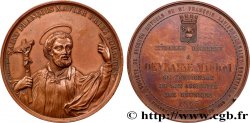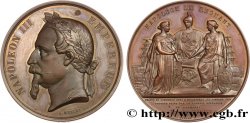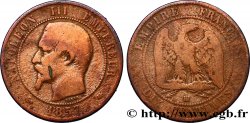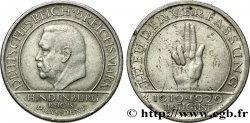fme_584070 - SEGUNDO IMPERIO FRANCES Médaille de l’annexion de la Savoie et de Nice à la France
No disponible.
Artículo vendido en nuestra tienda (2021)
Precio : 150.00 €
Artículo vendido en nuestra tienda (2021)
Precio : 150.00 €
Tipo : Médaille de l’annexion de la Savoie et de Nice à la France
Fecha: 1860
Nombre del taller / ciudad: France, Savoie / Nice
Metal: estaño
Diámetro: 50 mm
Eje de acuñación: 12 h.
Acuñador CAQUÉ Armand Auguste (1795-1881)
Peso: 56,66 g.
Canto: lisse
Cuño: sans poinçon
Comentarios sobre el estado de conservación:
Exemplaire ayant été légèrement nettoyé au droit. Reliefs nets
N° en los catálogos de referencia :
Anverso
Titulatura del anverso: NAPOLEON III - EMPEREUR.
Descripción del anverso: Tête laurée à gauche ; signé au-dessous CAQUÉ F..
Reverso
Titulatura del reverso: ANNEXION DE LA SAVOIE ET DU COMTÉ DE NICE A LA FRANCE - 1860 // SAVOIE / VOTANT : 130.839. / SUFFRAGES : 130.533. / 22 ET 23 AVRIL / - / NICE / VOTANTS : 26.023. / SUFFRAGES : 25.648. / 15 ET 16 AVRIL /.
Descripción del reverso: Légende en huit lignes ; signé : MASSONET ED..
Comentario
L'Annexion de la Savoie est le nom générique donné à la réunion, selon l’expression utilisée dans le traité de Turin, de l’ensemble de la Savoie (futurs départements de la Savoie et de la Haute-Savoie), correspondant au duché homonyme, et du comté de Nice, alors partie intégrante du royaume de Sardaigne, à la France en 1860. Bien que le pays fût occupé, voire annexé, à plusieurs reprises (par les Français : 1556-1559 ; 1600-1601 ; 1689 puis 1703-1713 ; par les Espagnols 1742-1749 ; à nouveau par la France durant la Révolution de 1792 à 1814), l’expression renvoie à la clause de « réunion » prévue par l'Article premier du traité de Turin du 24 mars 1860.
Le plébiscite se déroule les 22 et 23 avril 1860 : c'est la première élection au suffrage universel en Savoie, et les électeurs doivent répondre à la question « La Savoie veut-elle être réunie à la France ? ». « Pour Napoléon III, il ne s'agit pas de demander l'avis des citoyens mais de démontrer que sa politique bénéficie d'un soutien populaire. Tout se trouve mis en œuvre pour que les résultats du vote répondent aux attentes de l'Empereur » explique un historien. Les conditions de vote ne permettraient pas de caractériser aujourd'hui le vote de totalement démocratique ; « Les urnes étaient aux mains des mêmes autorités qui avaient issues les proclamations. Les contrôles étaient impossibles », les églises chantent la messe et le "Domine salvum fac Imperatorem" (Seigneur protège l'empereur). Bien que le travail des conservateurs fut très important, pour l'historien Paul Guichonnet, l'Annexion est « l’œuvre avant tout du clergé ». Le docteur Truchet d'Annecy commentait ainsi cette période « Si les six cents curés savoyards eussent fait opposition à l'annexion, la presque unanimité eût été en sens inverse, soyez-en bien sûrs ». Guichonnet souligne d'ailleurs que cette orientation du clergé savoyard s'est faite «contre l’orientation laïque et pro-italienne de Cavour, par l’aristocratie et le clergé, encadrant des masses rurales sans éducation politique».
The Annexation of Savoy is the generic name given to the union, according to the expression used in the Treaty of Turin, of the whole of Savoy (future departments of Savoy and Haute-Savoie), corresponding to the homonymous duchy, and the County of Nice, then an integral part of the Kingdom of Sardinia, to France in 1860. Although the country was occupied, or even annexed, on several occasions (by the French: 1556-1559; 1600-1601; 1689 then 1703-1713; by the Spanish 1742-1749; again by France during the Revolution from 1792 to 1814), the expression refers to the \\\"reunion\\\" clause provided for by Article 1 of the Treaty of Turin of March 24, 1860.
The plebiscite took place on April 22 and 23, 1860: it was the first election by universal suffrage in Savoy, and voters had to answer the question \\\"Does Savoy want to be reunited with France?\\\". \\\"For Napoleon III, it was not a question of asking the opinion of citizens but of demonstrating that his policy enjoyed popular support.\\\". \\\"Everything is being done to ensure that the results of the vote meet the Emperor's expectations,\\\" explains a historian.. The voting conditions would not allow us to characterize the vote as totally democratic today; \\\"The ballot boxes were in the hands of the same authorities who had issued the proclamations. Controls were impossible,” the churches sing the mass and the “Domine salvum fac Imperatorem” (Lord protect the emperor). Although the work of the conservatives was very important, for the historian Paul Guichonnet, the Annexation was \\\"above all the work of the clergy.\\\". Doctor Truchet of Annecy commented on this period thus: \\\"If the six hundred Savoyard priests had opposed the annexation, almost unanimity would have been in the opposite direction, you can be sure of that.\\\". Guichonnet also underlines that this orientation of the Savoyard clergy was made \\\"against the secular and pro-Italian orientation of Cavour, by the aristocracy and the clergy, supervising rural masses without political education\\\"
Le plébiscite se déroule les 22 et 23 avril 1860 : c'est la première élection au suffrage universel en Savoie, et les électeurs doivent répondre à la question « La Savoie veut-elle être réunie à la France ? ». « Pour Napoléon III, il ne s'agit pas de demander l'avis des citoyens mais de démontrer que sa politique bénéficie d'un soutien populaire. Tout se trouve mis en œuvre pour que les résultats du vote répondent aux attentes de l'Empereur » explique un historien. Les conditions de vote ne permettraient pas de caractériser aujourd'hui le vote de totalement démocratique ; « Les urnes étaient aux mains des mêmes autorités qui avaient issues les proclamations. Les contrôles étaient impossibles », les églises chantent la messe et le "Domine salvum fac Imperatorem" (Seigneur protège l'empereur). Bien que le travail des conservateurs fut très important, pour l'historien Paul Guichonnet, l'Annexion est « l’œuvre avant tout du clergé ». Le docteur Truchet d'Annecy commentait ainsi cette période « Si les six cents curés savoyards eussent fait opposition à l'annexion, la presque unanimité eût été en sens inverse, soyez-en bien sûrs ». Guichonnet souligne d'ailleurs que cette orientation du clergé savoyard s'est faite «contre l’orientation laïque et pro-italienne de Cavour, par l’aristocratie et le clergé, encadrant des masses rurales sans éducation politique».
The Annexation of Savoy is the generic name given to the union, according to the expression used in the Treaty of Turin, of the whole of Savoy (future departments of Savoy and Haute-Savoie), corresponding to the homonymous duchy, and the County of Nice, then an integral part of the Kingdom of Sardinia, to France in 1860. Although the country was occupied, or even annexed, on several occasions (by the French: 1556-1559; 1600-1601; 1689 then 1703-1713; by the Spanish 1742-1749; again by France during the Revolution from 1792 to 1814), the expression refers to the \\\"reunion\\\" clause provided for by Article 1 of the Treaty of Turin of March 24, 1860.
The plebiscite took place on April 22 and 23, 1860: it was the first election by universal suffrage in Savoy, and voters had to answer the question \\\"Does Savoy want to be reunited with France?\\\". \\\"For Napoleon III, it was not a question of asking the opinion of citizens but of demonstrating that his policy enjoyed popular support.\\\". \\\"Everything is being done to ensure that the results of the vote meet the Emperor's expectations,\\\" explains a historian.. The voting conditions would not allow us to characterize the vote as totally democratic today; \\\"The ballot boxes were in the hands of the same authorities who had issued the proclamations. Controls were impossible,” the churches sing the mass and the “Domine salvum fac Imperatorem” (Lord protect the emperor). Although the work of the conservatives was very important, for the historian Paul Guichonnet, the Annexation was \\\"above all the work of the clergy.\\\". Doctor Truchet of Annecy commented on this period thus: \\\"If the six hundred Savoyard priests had opposed the annexation, almost unanimity would have been in the opposite direction, you can be sure of that.\\\". Guichonnet also underlines that this orientation of the Savoyard clergy was made \\\"against the secular and pro-Italian orientation of Cavour, by the aristocracy and the clergy, supervising rural masses without political education\\\"








 Informar de un error
Informar de un error Imprimir la página
Imprimir la página Comparte mi selección
Comparte mi selección Haz una pregunta
Haz una pregunta Consignar / vender
Consignar / vender
 Descriptivo
Descriptivo











